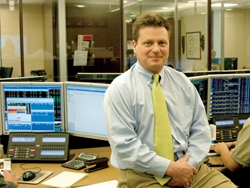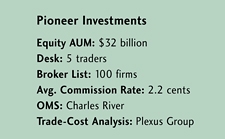Bob Gauvain, director of U.S. trading at Pioneer Investments in Boston, doesn’t have to look far for insights into investing or trading. His firm’s Pioneer Fund was launched by legendary value investor Phil Carret in 1928, making it among the first mutual funds. An original $10,000 fund investment became $8 million.

Carret was an icon for value investors everywhere-including Warren Buffet, who said Carret “had the best long-term investment of anyone I know.” Carret’s nearly 80-year-old book “The Art of Speculation” is a classic. For Gauvain, some of the wisdom of the firm’s founder is within reach in the writings of Carret, who died in 1998 at the age of 101. Or it could come from a conversation with current Pioneer Fund manager John Carey, for whom Gauvain traded for earlier in his career.
One quote from Carret’s book is as relevant today for traders as it was when it was written, given the recent volatility. However, the context is different nowadays. Carret wrote in 1930: “Like the ocean, the stock market is never still.”
The same could be said for marketplace orders today, Gauvain says. With the use of algorithms that move orders from dark pool to dark pool, orders in the market are “never still.” Of course that wasn’t the case just a few years ago, Gauvain says, before dark pools changed the market. Reserve orders were usually found in the back pockets of sales traders and floor brokers.
To continue Carret’s water metaphor, Gauvain says that traders need to find “the currents” of liquidity. And that’s difficult in today’s fragmented market. “You have to find all the different currents,” says Gauvain, a former boater who still enjoys fishing. “You sail the ship in whichever current is the best.”
Pioneer’s desk has found those hidden currents by executing nearly 70 percent of its trading volume electronically, Gauvain says. In fact, the ratio of low-touch to high-touch didn’t stray much from that 70:30 formula during the volatile months. He backs that with what he considers the desk’s high first-quarter trading-cost rankings.

Although Gauvain rarely trades, he says that a head trader must understand the new technologies: “You have to know what each technology does or doesn’t do and how it can be integrated into your desk and your firm’s investment style.” Essentially, his job is to give his traders the best chance to successfully compete.
He likened his head-trading role to that of a general manager in baseball. He’s the one who has to give his traders–Ed Doyle, Dan Sim and Nick Lambros and Sofia Sermos–the right tools so that they can make plays. But to deliver those tools, Gauvain needs to spend time reading about the business, understanding the various new products. Sometimes, he catches up on weekends. The good news is that it hasn’t cut into his fishing just yet, he says. “My fishing time is my Zen time.”
(c) 2008 Traders Magazine and SourceMedia, Inc. All Rights Reserved.
http://www.tradersmagazine.com http://www.sourcemedia.com




